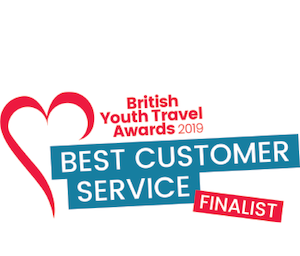Our planet exists with a delicate balance of life, forged over millions of years. Human activity has expanded to disrupt this balance, increasing the number of endangered animals. Many species have become extinct and plenty more are on the brink.
Do you want to be a part of the effort to save the animals we have left? We believe that wildlife volunteers have the power to make a difference.
Below, discover why animals are threatened, how they’re classified, and ten animals that need the protection of wildlife volunteers. You'll also learn about ethical animal volunteering opportunities - keep reading to find the perfect one for you.
Here’s how you can make the world a better place for your fellow animals.
10 Vulnerable Animals

It may seem impossible to help every vulnerable species, but you can focus your efforts where they’ll make the biggest difference. To help you decide where to volunteer, here are 10 animals that need protection:
- Rhino
- Lion
- Leopard
- Elephant
- Buffalo
- Giraffe
- Giant tortoise
- Sea turtle
- Whale
- Shark
Wildlife volunteers can protect vulnerable animals by picking a species they’re passionate about saving. No single person can save the world, but we can all do our bit.
Want to get stuck in? Check out our rundown of the best animal volunteer projects.
To figure out which species need your help, start by learning why animals need protection in the first place.
What Threats Do Animals Face?
Volunteering with animals is a chance to defend animals against the threats of the modern world. As a wildlife volunteer, you’ll travel to exciting new countries, where you’ll help conserve safe areas for animals.
We need wildlife conservation for three main reasons:
- Loss of habitat
- Illegal hunting
- Climate change
Conservation areas are created to protect the habitats of animals while carving out an area that is safe from poachers.
Worried about the ecological impact of travelling to a wildlife conservation project? We’ve launched a climate action plan aiming to offset 110% of our carbon emissions by 2023.
How are Animals Classified as Endangered?

All animals (including humans) are organised into seven groups. Their group is their conservation status, decided by the International Union for Conservation of Nature (IUCN) through periodic assessments.
The seven conservation statuses are:
- Least concern: These animals have a large and widespread population, with little chance of extinction.
- Near threatened: Although they’re not on the danger list yet, they will likely be soon.
- Vulnerable: The existence of these animals is at risk and wildlife volunteers are needed to protect them. These animals have experienced a population decline of 30%-50% over the last 10 years or three generations (whichever is longer).
- Endangered: When an animal reaches this level, a decline of 50%-70% has occurred over the same period.
- Critically Endangered: Population decline has reached up to 90% and we’re at the tipping point between species survival and extinction.
- Extinct in the Wild: While the species still exists, it only does so in captivity or hasn’t been spotted in the wild for many years.
- Extinct: The last member of the species has died and this is beyond any reasonable doubt. This is the reason we need to act early.
This system helps you decide where to focus your efforts when volunteering with animals. It has also influenced the animals we choose to protect in our Animal Conservation and Marine Conservation projects.
Protect the Big Five
When choosing which ten animals most require the help of wildlife volunteers, we should discuss the Big Five. This refers to some of Africa’s most majestic beasts.
Although they may be well-known, these animals urgently need your help. By volunteering on a Big Five wildlife conservation programme, you can come face to face with these incredible animals and contribute to the continued survival of their species.
What are the African Big 5?
- Rhino
- Lion
- Leopard
- Elephant
- Buffalo
Did you know? The term Big Five was originally used in a hunting context. These were the animals considered the biggest prizes for trophy hunters. This just shows how vulnerable these animals would be without the protection of conservation volunteers.
Why Do Rhinos Need Protection?

Conservation Status: Critically Endangered
Both black and white rhinos are dangerously close to extinction.
If you’ve ever seen one up close, then you’ll know just how powerful and beautiful a rhino is. Unfortunately, they can’t defend themselves against the threats posed by humans.
The rhino horn trade has made it difficult for this species to survive. Poverty has worsened the situation, with some people turning to poaching as a way to earn a living. In the long run, though, this isn’t sustainable.
These gentle giants are herbivores that don’t hunt other animals. However, rhinos shape their landscape with constant grazing and forge pathways for their fellow creatures. As they wallow in mud, rhinos also keep waterholes open for other thirsty animals.
Want to help protect rhinos in a stunning natural setting? Join Rhino Conservation in Nepal.
Why Do Lions Need Protection?

Conservation Status: Vulnerable
As such a powerful and well-known animal, you may be surprised that only around 20,000 lions exist today. Every effort is needed to protect what we have left and grow the lion population. The most recent IUCN assessment of lions, taken in 2014, found that numbers are declining.
Lions are among the world’s most awe-inspiring creatures. Beyond this, though, they’re crucial to the ecosystem. Being apex predators, they control populations of herbivores like zebra and wildebeest. That, in turn, helps sustain plant life.
In the words of Mufasa, “we are all connected in the great circle of life”.
You can help protect lions on wildlife conservation volunteer trips to Kenya or Botswana.
Why Do Leopards Need Protection?

Conservation Status: Vulnerable
Among the most beautiful creatures on the planet, leopards are poached for their soft fur. As a result, numbers have declined drastically. They’re also killed by farmers looking to protect their livestock.
Leopards are widespread, existing from southern Russia to Southeast Asia and across Sub-Saharan Africa. However, their numbers are in decline. Your work could contribute to restoring leopard population growth.
They’ve already been declared extinct in countries such as Uzbekistan and Jordan. They’re possibly also extinct in African countries like Lesotho and The Gambia. Wildlife volunteers are needed to prevent more widespread extinction.
Why Do Elephants Need Protection?

Conservation Status: Critically Endangered
The world’s largest land animals and among the most intelligent, elephants attract many wildlife volunteers. Despite the willingness of the public to save these incredible creatures, the survival of the African elephant is at risk.
The African savannah elephant was classified as endangered with a decreasing population in 2020 while the African forest elephant was classed as critically endangered the same year.
The greatest threat to these majestic creatures is the ivory trade. Without strong protections, poachers threaten the survival of elephants. Human activity is also destroying the habitats that elephants depend on.
Why Do Buffalos Need Protection?

Conservation Status: Near Threatened
Of the Big 5, buffalo are considered the least at risk. However, an IUCN assessment carried out in 2018 found them to be near threatened. This means that we must act now to stop them from becoming a vulnerable species.
Like rhinos, buffalo are considered a keystone species in that they forge new habitats for other wildlife. Zebras and wildebeest are fussy eaters, only interested in plants close to the ground. Buffalo will mow through the taller grass, creating space for other animals to graze. As their numbers decrease, other animals suffer.
Although buffalo may be less at risk than others, they still need the dedication of wildlife volunteers. Buffalo protection work in turn supports other animals that need protection.
African Big 5 Volunteer Work
Looking for a wildlife conservation project to protect vulnerable animals? You can help the five listed above by joining a Big Five Conservation Project. Based in remote Botswanan bushveld, you’ll help to create and maintain a space where vulnerable animals can safely roam free.
The African Big 5 are a great place to start as a wildlife conservation volunteer but there are still five more on this list! Keep reading for more inspiration on animals that need protection.
Volunteer With Giraffes

Conservation Status: Vulnerable
The tallest land animal, many people dream of coming face-to-face with a giraffe. Tragically, though, their numbers are dwindling. If you want to volunteer with animals, then working on a giraffe conservation programme may be worth your while. By monitoring their activities, you can help protect their habitat.
Are Giraffes Endangered?
Giraffes are currently classified as vulnerable, not endangered. However, with a declining population, giraffes may become endangered in the next few years. They haven’t been assessed since 2016 when the population was estimated at around 68,000.
Animal protection volunteers are needed urgently to stop numbers from declining even further. As human activity expands, giraffe habitats are shrinking and fragmenting. Acting now on animal conservation projects is essential.
How Can I Help Save the Giraffes?
Are giraffes top of your list of animals to protect? The best way to help would be to join our Giraffe and Lion Conservation Project in Kenya. You’ll live in a truly wild ranch house, observing giraffes and fixing waterholes. Careful monitoring reduces the risk of poaching and ensures giraffes have what they need to thrive.
Giant Tortoise Conservation

Conservation Status: Critically Endangered
Giant tortoises are fascinating but vulnerable animals. They’re currently only found in the Galapagos, where they’ve evolved to perform a similar role to that of rhinos in Africa. Grazing constantly, they keep the plant life in check and create room for other animals. They trample plants to create pathways throughout the landscape while spreading seeds.
How Many Giant Tortoises are Left in the World?
The Galapagos National Park is home to just 60,000 tortoises. Only 15,000 exist in the wild. For that reason, the giant tortoise is considered to be critically endangered. Without urgent action, we could see the end of this species within our lifetime.
This puts giant tortoises among the most vulnerable animals requiring the help of wildlife volunteers. You have the potential to make a real change by volunteering with animals in the Galapagos.
How Can We Help the Giant Tortoise?
The best way to support the continued survival of the giant tortoise is through wildlife conservation programmes. Wildlife volunteers can join our Giant Tortoise and Sea Lion Conservation Project for a chance to travel to the Galapagos and protect vulnerable animals.
We have a special relationship with the Galapagos National Park, meaning that only Projects Abroad volunteers are able to work there. Join our conservation programme to get hands-on with providing support to the animals of these amazing islands.
Save the Sea Turtles

Conservation Status: Vulnerable
Sea turtles require a carefully balanced ecosystem. Life begins inside an egg buried in the sand. The temperature of the nest determines the sex, so climate change is a clear threat to sea turtles. If the hatchlings make it safely to the sea, then they have a good chance of survival.
However, habitat destruction, poaching, and the fishing industry have put sea turtles in danger. Wildlife conservation volunteers can help protect these vulnerable animals, contributing to the continued survival of their species.
Are Sea Turtles Considered Endangered?
Most sea turtle species are rated as vulnerable by the IUCN. This is true for the olive ridley and leatherback sea turtles. The hawksbill turtle was most recently rated as critically endangered. In all instances, though, climate change, plastic pollution, and habitat destruction are threatening the survival of sea turtles.
How Can We Save the Sea Turtles?
As humans, we have the power to protect sea turtles and increase their chances of survival. This is best done through the support of wildlife volunteers working on marine conservation. You can join one of the following projects:
- Sea Turtle Conservation in Mexico
- Sea Turtle Conservation in Sri Lanka
- Animal Rehabilitation in the Amazon Rainforest
- Rainforest Conservation for Teenagers in Peru
All of these wildlife volunteer projects involve practical and impactful work. Volunteers collect turtle eggs and release them safely once hatched. Together we can help sea turtles thrive.
Whale Volunteer Programmes

Conservation Status: Endangered
Their underwater life remains a mystery to many, but below the surface, whales are doing crucial work for the planet. These secretive giants dive deep to feed, then release faecal plumes (i.e. go to the toilet) near the surface. This moves nutrients upwards, which plankton then feed off. These plankton remove carbon dioxide from the atmosphere and provide us with half of the oxygen we breathe.
Once again, isn’t it amazing how all life is connected? By protecting whales, we protect ourselves. Marine wildlife volunteers are essential in this process.
Are Whales Considered Endangered?
Different species of whales come with different conservation statuses. While the humpback whale is of least concern, the blue whale is classed as endangered. All whales are animals that need protection insofar as their existence is threatened by sea pollution, climate change, and commercial whaling.
How Can People Help the Whales?
Wildlife volunteers can help protect whales through a marine conservation programme. Your best option would be the Whale and Puma Conservation Project in Argentina. You’ll live on a wildlife refuge on the Patagonian coast, taking a census of whale populations. By monitoring and observing whales, you’re helping to protect some of the world’s most vulnerable animals.
Volunteer With Sharks

Conservation Status: Vulnerable
They have a scary reputation but the truth is that sharks are vital to our ecosystem. As apex predators, they intimidate and eat their prey, which limits the destruction of seagrass meadows. Seagrass plays a crucial role in offering shelter to marine life and absorbing CO2. Sharks keep this habitat intact.
Like many other marine animals, sharks are often caught for food or as a by-product of the fishing industry. As human existence expands into the seas, we’re disturbing their habitats. Sharks are now vulnerable animals that wildlife volunteers must protect.
Are Sharks Endangered?
This depends on the species, but most sharks are rated as either vulnerable or endangered. The great white shark and bull shark are vulnerable, the whale shark is endangered, and the hammerhead is critically endangered. All species of shark experience similar threats. They’re either endangered animals already or likely to be so soon.
How Can We Help Conserve Sharks?
Shark conservation may seem difficult but it’s something that wildlife volunteers have become pretty good at. If you want to protect sharks, then a marine conservation trip is a great way to make a difference. Take a look at Shark Conservation Volunteering in Fiji.
Above are just ten from a long list of animals that need protection. The world needs more wildlife volunteers who understand the importance of vulnerable animals to our planet.
Ready to make a difference? Fill out the form below to start your search for a wildlife conservation project that you can get excited about.
Enquire Now
Want to volunteer with animals?
Get in touch to find your next wildlife project
Our accreditations



















